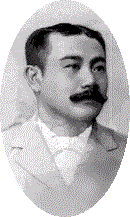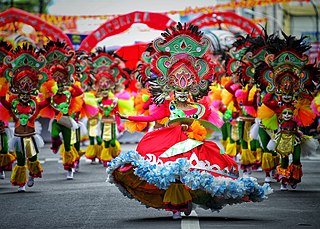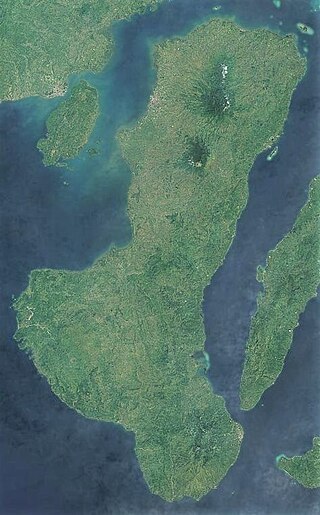
Negros Occidental, officially the Province of Negros Occidental (Hiligaynon: Kapuoran sang Nakatungdang Negros (Negros Occidental; Tagalog: Lalawigan ng Kanlurang Negros, is a province in the Philippines located in the Western Visayas region. Its capital is the city of Bacolod, of which it is geographically situated and grouped under by the Philippine Statistics Authority, but remains politically independent from the provincial government. It occupies the northwestern half of the large island of Negros, and borders Negros Oriental, which comprises the southeastern half. Known as the "Sugarbowl of the Philippines", Negros Occidental produces more than half the nation's sugar output.

Bacolod, officially the City of Bacolod, is a 1st class highly urbanized city in the region of Western Visayas, Philippines. It is the capital of the province of Negros Occidental, where it is geographically situated but governed administratively independent.

Silay, officially the City of Silay, is a 3rd class component city in the province of Negros Occidental, Philippines. According to the 2020 census, it has a population of 130,478 people.

Talisay, officially the City of Talisay, is a 4th class component city in the province of Negros Occidental, Philippines. According to the 2020 census, it has a population of 108,909 people.

Aniceto Ledesma Lacson was the first and only president of the Negros Republic from 1898 to 1901. He is notable for leading the Negros Revolution along with Juan Araneta. He is also an essential figure amongst Negros Occidental's landed gentry where he not only contributed significantly to the burgeoning sugar industry, but also helped shaped the political landscape of the province during his time.
Ruins are the remains of man-made architecture.

The Republic of Negros was a short-lived revolutionary entity which had existed on the island of Negros first as a canton of the First Philippine Republic and later as a protectorate of the United States.

The Negros Revolution, commemorated and popularly known as the Fifth of November or Negros Day, was a political movement that in 1898 created a government on Negros Island in the Philippines, ending Spanish control of the island and paving the way for a republican government run by the Negrense natives. The newly established Negros Republic lasted for approximately three months. American forces landed on the island unopposed on February 2, 1899, ending the island's independence. Negros was then annexed to the Philippine Islands on 20 April 1901.

The MassKara Festival is an annual festival with highlights held every 4th Sunday of October in Bacolod, Philippines. The festival sites include the Bacolod Public Plaza, the Lacson Tourism Strip and the Bacolod City Government Center.

The Mariano Ramos Ancestral House is the home of the late Mariano Ramos, one of the first appointed Presidente Municipals of Bacolod, Philippines. The house was built in the 1930s with its architecture being a combination of Castilian and Tuscan styles. It comprises three storeys including the tower room, known as the torre or mirador.

The Balay Negrense, also as Victor Fernandez Gaston Ancestral House is a museum in Silay City, Negros Occidental in the Philippines, showcasing the lifestyle of a late 19th-century Negrense sugar baron. It is notable for being the first museum to be established in the province of Negros Occidental.
The Negrenses are the native cultural group of the Philippine provinces of Negros Occidental, Negros Oriental and Siquijor.

The Bacolod Metropolitan Area, simply known as Metro Bacolod, is the 8th-most populous and the 6th-most densely populated metropolitan area out of the 12 metropolitan areas in the Philippines. This metropolitan area as defined by the National Economic and Development Authority (NEDA) has an estimated population of 1,435,593 inhabitants as of the 2020 official census by the Philippine Statistics Authority.

Ancestral houses of the Philippines or Heritage Houses are homes owned and preserved by the same family for several generations as part of the Filipino family culture. It corresponds to long tradition by Filipino people of giving reverence for ancestors and elders. Houses could be a simple house to a mansion. The most common ones are the "Bahay na Bato". Some houses of prominent families had become points of interest or museums in their community because of its cultural, architectural or historical significance. These houses that are deemed of significant importance to the Filipino culture are declared Heritage House by the National Historical Commission of the Philippines (NHCP), previously known as the National Historical Institute (NHI) of the Philippines. Preservation is of utmost importance as some ancestral houses have come into danger due to business people who buy old houses in the provinces, dismantle them then sell the parts as ancestral building materials for homeowners wishing to have the ancestral ambiance on their houses. These ancestral houses provide the current generation a look back of the country's colonial past through these old houses.

Negros is the fourth largest and third most populous island in the Philippines, with a total land area of 13,309 km2 (5,139 sq mi). The coastal zone of the southern part of Negros is identified as a site of highest marine biodiversity importance in the Coral Triangle.

Hacienda Rosalia, also known as Hacienda Santa Rosalia, is a compound where the ancestral home mansion of Gaston family and the Church of Cartwheels are located. It is situated in Manapla, Negros Occidental, Philippines. The mansion was built in 1930s.
The Museo Negrense de La Salle is located within the campus of the University of St. La Salle in Bacolod, Philippines beside the St. La Salle Coliseum. It is the only school-based museum in the Negros region.

The Dizon-Ramos Museum is situated in Bacolod, Negros Occidental, Philippines beside the Mariano Ramos Ancestral House.

The Silliman Hall is a building constructed in the Stick Style of American architecture in Dumaguete, Negros Oriental, Philippines. It was built in the early 1900s. It was converted to a museum in 1970. It is located in Dumaguete, Negros Oriental, Philippines.

Dr. Jose Corteza Locsin Ancestral House is a two-storey house built in the 1930s in Silay, Negros Occidental Philippines. It has been named as a Heritage Houses of the Philippines by the National Historical Commission of the Philippines. It was the home of Jose Locsin (1891–1977), a Filipino medical doctor and senator.






















